AUTHOR OF 'WINDOW SEAT'
An Interview With Julieanne Kost
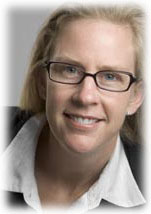 By MIKE PASINI
By MIKE PASINIEditor
The Imaging Resource Digital Photography Newsletter
You may know Julieanne Kost from her amusing Photoshop lectures ("How do you pronounce GIF? Get a life!") or her Classroom in a Book Series for Adobe, for whom she's worked since 1993. As a Senior Digital Imaging Evangelist, she flies all over the world, lecturing on creativity and Photoshop (and Lightroom, too, now) for Adobe.
As she flies from one city to another, Julieanne shoots photos from her window seat. And, after five years of taking pictures of the sky from the sky, she's published Window Seat, a down-to-earth book on creativity, photography and digital imaging. It's a unique book, featuring sections that sandwich her portfolio of images culled from 3,000 originals between advice on remaining creative in a need-it-yesterday world and a technical appendix that reveals the equipment and techniques used to create the images reproduced in the book.
We chatted briefly with Julieanne about the book at an Adobe event during the Photo Marketing Association's trade show in February and followed up with an email interview.
THE INTERVIEW | Back to Contents
First, outright prolonged applause! The book arrived just before the PMA trade show and just after lunch one afternoon. We propped up our feet and went straight through it, only occasionally reaching up for a call light to get some peanuts.
The idea of shooting out the window was the first thing that amused us. Such a prescription for disaster, we had to wonder how you managed.
But we quickly got tangled in the broader scope of the book. The argument for creativity in a Post-it notes world. Practical advice, but not heavy handed.
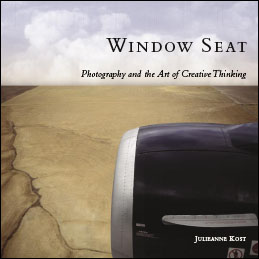 |
| The Cover |
Finally, much as we dreaded yet another technical discussion, we found this one, like the encouragement toward creativity, hit just the right tone. Comprehensive but not a tour of the menus. The smart way to solve certain problems, achieve certain effects.
Q. The book's organization in three sections (manifesto, portfolio, manual) is unusual. How did you arrive at this particular structure for the book?
A. I wanted this book to be more than another "How-to" book for Photoshop. Book after book focuses on what the tools do and how to achieve certain effects. I wanted to spark people's right brain for a change. You're creating a certain effect in Photoshop, but what's your point? What are you trying to convey? The creation of an image goes far beyond the tool (or tools) and methods used to create it. In the beginning, there's the concept stage. Essentially, this is where you need to create "something from nothing." You may have an idea or an emotion, but how do you convey it visually? Hence, the "ways to stay creative" section. Then I wanted people to get a feel for the process. And finally, I wanted to cover workflow to get a feel for what I do. It's not a "recipe" by any stretch, but an overview of the "nuts and bolts" of what I use and why I choose them. My editor, Edie Friedman, was actually the one that came up with the three-part approach. The book would never have been so well sequenced without her!
MANIFESTO: THE ART OF CREATIVE THINKING | Back to Contents
Q. You talk about the Cinderellish feeling that you have to finish your chores before you can go to the ball. And yet some mindless chore, you observe in the next paragraph, can clear your mind of workaday worries and set the stage for some fun. Do these little 'negotiations' become easier to win as they become habits?
A. Well, I do feel compelled to finish my chores before I will "reward" myself with time to work on my art. I believe this is due to my being very conscious of my environment. If I am not at peace with my surroundings, then I have a difficult time concentrating on the task at hand. If I can't let go of these things and keep being distracted by them and they end up ruining my time that I work. The mindless chores allow me to transition to this better place where I can then concentrate.
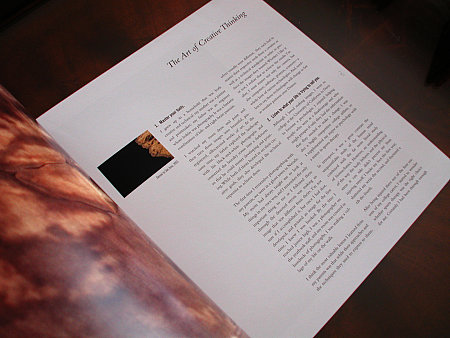 |
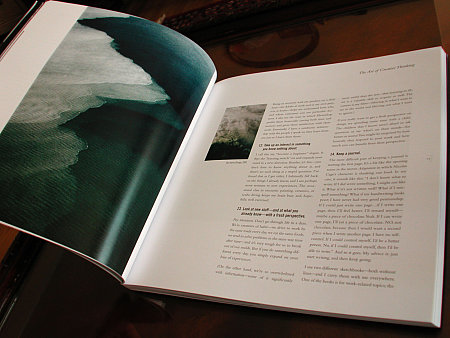 |
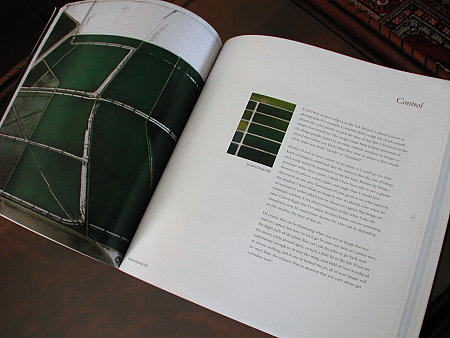 |
| Spreads From 'Manifesto' |
Q. You write about being open to stimuli like subjects you know nothing about and hanging out with kids but also the need to reflect on these stimuli in, for example, a journal. And rereading an old journal for perspective. But we're all busy charging batteries and talking on the phone. What's the trick to finding the time (and on a regular basis; or was the project easy to pick up and put down)?
A. There is no magic trick to finding the time and honestly it is always a challenge. It takes a great deal of discipline to continue to work on a long term project and there are definitely some days that are better than others. But I enjoyed this project so much and I knew that the result of the effort would be worth it. I suppose that keeping my eye on the final project helped me through the more monotonous parts of it. As for referencing journals I think its essential for me to take the time to do this because they have been the source of many of my digital illustrations. I know that I must write ideas and thoughts down when they're fresh in my mind because I would forget them otherwise.
Q. You advised us to first visualize then Photoshop. You might have substituted any camera model for Photoshop, too (first visualize then Canon SD400). Why does the tool tend to get in the way?
A. I don't think that it necessarily gets in the way, but I think that -especially in the case of Photoshop is that it actually gives you too many possibilities. Because of the vast number of choices that it presents to you, you might spend a lot of time going in a direction that you didn't intend and doesn't connect you to your original goal. Although this can lead to incredible imagery -- the "happy accident" -- it can also distract you from getting to the point that you set out to make.
Q. Break the rules, play, know when you're done, you write. Of course, it's hard to break the rules if you don't know them. And nearly impossible to finish if you don't start. You had some formal training in photography after college. Having been through it would you recommend technical training? Art school? Do the old lessons come into play much?
A. Absolutely. I would always encourage that everyone continues their education through out their lives. I believe that one of the reasons that I have been able to create the images that I have is because I have mastered the tools so they no longer get in the way. I can create the images that I want rather than the images I can coax out of the tools.
Q. You mentioned when we spoke briefly at PMA that you weren't aware of Wayne Thiebaud's aerial paintings. But how about other influences? Robert Cameron (Above San Francisco, etc.), perhaps? Reading the technical section on image manipulation reminded us of Ansel Adams' series on the Camera, Negative and Print. Anyone inspire you?
A. There are many photographers who have inspired me. One of the first was John Sexton -- however there have been many more over the years -- Jerry Uelsmann, Maggie Taylor, John Paul Caponigro and Ryszard Horowitz have also had a significant influence on my work. I enjoy looking a wide range of images and try to look at as much as I can as often as I can.
PORTFOLIO: WINDOW SEAT | Back to Contents
You said this was a natural project for you. Afraid of flying, photographing out the window gave you objective distance on a constantly scrolling subject. We tried it on the flight home from PMA and have to say it's a lot more fun than counting license plates. Even more, these images that are otherwise fleeting, can be revisited without going through airport security again. And they are, as you point out, pure in a way our littered landscape at ground level never is.
Q. Editing 3,000 images to just 150 must have taken some discipline. You offer no advice for this in the book <g>. How did you tackle that problem?
A. Well, I think it's more difficult to edit 200 images down to 150. <g> I began by choosing my favorites, but this still left me with about 400 "favorite" images. What is interesting and encouraging to me is that the number of images that are included in the book which were taken in the past 2-3 years is much greater than the number of images that were taken at the beginning of the project. I hope that I can conclude that means that the quality of the images that I was capturing improved over time. That I got better at identifying what made a particular image interesting or unique. At the beginning, all of the textures and patterns and lighting were unique. But over time, patterns emerged. I saw a better example of an image I had taken before, so the new one won out. There were also a lot of similar images in which case, I simply selected the best of them. Of course it was difficult to narrow down the last 25. There are a few images that I wish would have made it into the book, but I believe that I had a more emotional attachment to them. They weren't actually the best of the images, but they meant something to me (I remember the difficulty of making one of the images when there was significant turbulence for example). And of course multiple people -- including my editor Edie Friedman, my husband Daniel Brown and several friends -- looked at the images and provided opinions which were very helpful.
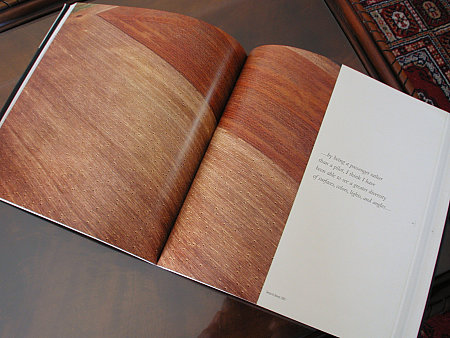 |
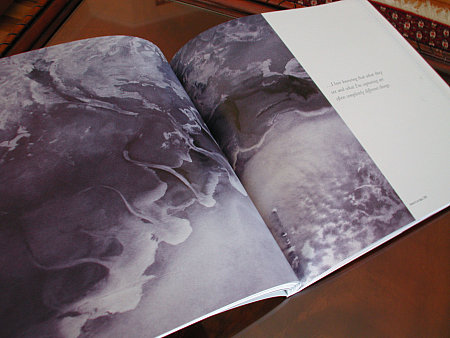 |
| Spreads From 'Portfolio' |
Q. The 10x10-inch page format accommodates all sorts of aspect ratios. You settled on just a few, you said. Was this strictly a production efficiency?
A. No, I prefer a square format, but most of these images were begging to remain at their captured aspect ratio. I try to always shoot full frame so that I don't have to crop. This is primarily to capture as much information as possible so that I can enlarge the image if desired.
Q. Do you make display prints of these images (apart from the 4x6s you used to select them for publication)? What size? Robert Cameron says that aerials need to be large and you mention the preferred size for these would be actual size. Have you framed any for display at home?
A. Yes, I have made display prints of the majority of the images. However I don't have room in my house to display them so that's a limiting factor. I have projected them many times on large screens and that's why I made the comment that they look so great large.
Q. How did you feel about including the wing in some images? They make a dramatic variation, reminding us where we are, but wasn't that a little unnerving? Was it an experiment, a gamble, that worked out?
A. Sometimes including the wing is unavoidable. But I don't have a problem with including it. I believe it adds to the image. Gives it a point of reference. It's also a great contrast -- the solid, straight, mechanical cold metal of the plane is the vehicle for the perspective behind it. There's also an interesting connection in that the air which is filled with various substances and provides different lighting, is also mechanism holding the plane up. From a distance, air makes for beautiful imagery, but it's invisible up close.
Q. You didn't shoot during takeoffs and landings, where you might have captured the urban environment. Was this a choice (not your cup of tea) or a necessity (the captain has requested you turn off all electronic devices)?
A. I have taken a lot of images on takeoff and landing, but I'm not interested in documenting man's footprint on the earth, perhaps this is a project that I can do in the future. I'm also a bit too terrified during takeoff and landing to shoot a good picture. I need my hands to grip the armrest. <g>
Q. You discuss the difficulty of using a point-and-shoot to capture images from a window seat. We were surprised by our own little experiment coming back from PMA. Underexposing slightly, shooting out the opposite side of the plane from the sun, with the lens against the window yielded good results. It seems easier than with a film camera if for no other reason than you can evaluate your results immediately and make some adjustments. How did you evaluate your exposures in flight?
A. With film, I went by the meter. With digital, I evaluated the histogram for the image to see the dynamic range (or lack thereof). Because there is such a lack of dynamic range when shooting from inside of the multiple windows (which are sometimes also quite dirty!), I shoot in the raw format. Shooting in raw gives me much higher quality and allows me to process the files and make significant changes to their tonal range which I wouldn't be able to do if I were working with a compressed JPEG file.
Q. Nobody ever asks what you're doing, you said. We noticed that. Perhaps it was pity (we did feel like we were imitating a person who had never been on a plane before). Did anyone ever make any comment about what you were doing?
A. No. But that might have been due to my body language that was telling them that I didn't want them to ask me anything. Or the ear plugs that I wear.
Q. In Photoshop, your goal you say wasn't to "correct" the image so much as to manipulate it toward what had originally impressed you about the scene. Did you feel completely free to deviate from what the camera captured -- and free from what you knew Photoshop could do?
A. Sure, this was my personal project, so I was trying to recreate what I experienced and what the image "felt" like. I wasn't trying to document a flight or place or time.
Q. Over five years, you developed themes of storm clouds, mountains, polar ice, hay fields. The book finalized the collection in a way a shoebox can't. Is the book, more than the prints, the final expression? Or was it the journey?
A. It was the journey, but it's wonderful to have a physical, tangible object that resulted from it.
MANUAL: IMAGING TECHNIQUES | Back to Contents
This is a pretty nice primer on image editing, period. All you'd ever need, forgive the expression, if you were stranded on a deserted island.
Q. Early shots were taken with a film Nikon whose prints you scanned. Later you used a Nikon dSLR, shooting Raw. In both cases, you would have had 16-bit channels, giving you a lot more headroom for tonal and color manipulation. The brightness range of the subject certainly demands that, but as you shoehorned that range into what printing press could reproduce, what were your guidelines?
A. Actually, I was shooting chromes so I was scanning those -- just FYI. The press actually determined the conversion to CMYK, so I just did my best to keep the colors in gamut while I was working on the files. I did provide Epson proofs to the printers in hopes that they would be able to match the colors. <g>
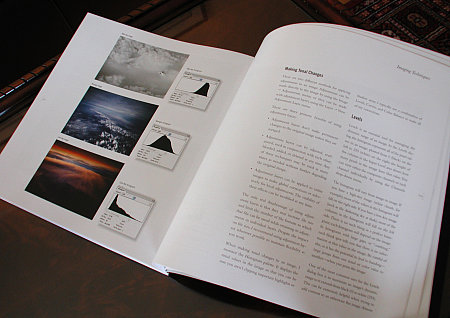 |
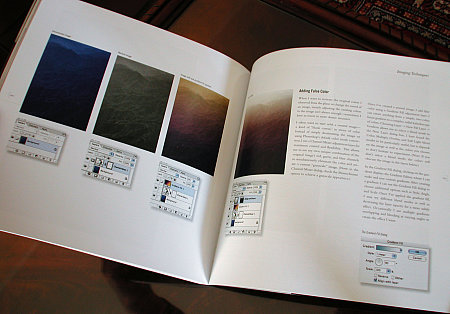 |
| Spreads From 'Manual' |
Q. You didn't use a very long lens, shooting no more than 70mm with the film camera and about a 100mm 35mm equivalent with the D100. In practice, did you prefer to work at the wide-angle end of the zoom range? Did you avoid focal lengths beyond 100mm for a reason?
A. No, to be honest I typically only travel with one lens and that is the length that I most often take with me. Since I typically travel with two computers, my Wacom tablet, an external drive, my cell phone and all of the power cords, plugs and adaptors that go with the equipment, a book, my journal a bottle of water etc. -- I just can't carry much more!
Q. You also didn't use a polarizing filter, you said, because it reacted oddly with the plane window. But did you use a Sky or UV filter on the lens?
A. I keep a UV filter on nearly all of my lenses to protect them. Other than that, any "filtering" was done in Photoshop.
Q. Page 132 was a favorite, showing high-key, average and low-key histograms. Not the ideal (and mythical) histogram, in short. No clipping either.
A. Since every histogram is just the representation of the values in the image, there really is no right or wrong histogram. They're completely dependent of the image. What you have to be careful of is the image that isn't properly exposed -- the one that clips the highlights or shadows to pure black or white where you the photographer probably would prefer there to be detail.
Q. Finally, how about a sequel -- say, 'Return Trip'?A. What a brilliant idea!
Window Seat by Julieanne Kost, published by O'Reilly Media Inc., 152 pages, $39.99.